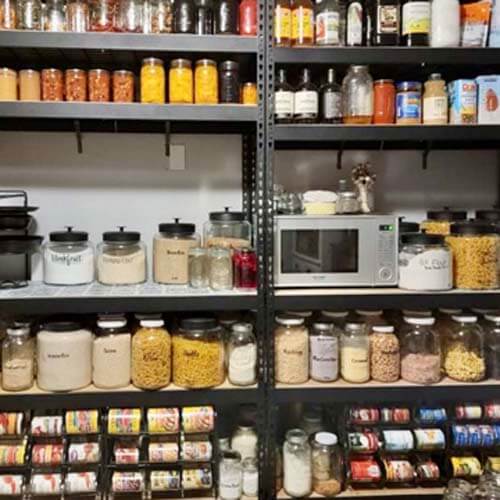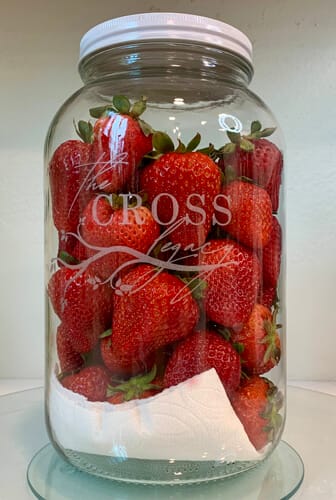DISCLOSURE: This post may contain affiliate links. Which means if you make a purchase through my links, I receive a small commission at no cost to you. For more information, please read my Disclaimer .

We only recently when viral for #strawberriesinajar. Using a sharpie and glass containers to store food have been part of our food storage process for years. See how I use both in our pantry to keep items fresh for a longer period of time here.
I use the slower days of January to go through my pantry and freezers. The kiddos are back to school and there are no more holiday plans to cloud the schedule. I take a complete inventory of what we have. This gives me a great chance to look and see what needs to be used up. Doing it at the same time each year allows me to take stock of our year-long food supply as well.
I mean, who doesn’t like to save money come January, after all that holiday spending? When you know how to keep inventory and learn to use what you have, you save money and lessen stress.
I Go Through This Process Three Times A Year
January:
I normally go through the inventory process of my pantry and freezers three times a year, starting in January. This is when I make my detailed list. I really go through everything and see what might expire in the next six months. I use those items to make meals to finish them off.
This is also the time that I go through the bathroom cabinets and linen closet. These places are where we keep our first aid supplies and supplements, and I am checking expiration dates. I make a list of items that we are running low on so I can add them to my detailed list. As I put things away after returning home from my grocery shopping trip, I always put them away in order of date: newest in the back and oldest in the front. This may sound a little daunting at first, but it isn’t too bad after you have a system going.
April (around Easter):
The next time I do a check is right around Easter. It is a good time for me to look at my batch-cooked meals in the freezer and use them up. For us, it is still cool enough in the spring that we can turn on the oven without worrying about heating the house. If there are other soups or wintery-type items, I try to get those eaten up around Easter time. This allows me to make room for a seasonal switch to summer items.
September:
September always feels like a fresh start to me. The kids are back in school and everyone is trying to get into the swing of routine again. This time of year, I am mostly checking the freezer for any leftover packages of hotdog buns. I swear, it’s always hotdog buns. Father of the Bride, anyone? It seems like they are the one thing that we never eat in the wintertime. They always seem to get lost in the freezer.
I take part in Jordan Page’s Shelf Cooking “shelftember” challenge every year. The timing is perfect for using up the last bits of things. This time of year, I am finding creative ways to use up the last bits of food in the freezer. This could be a cup of frozen veggies in a bag, or two frozen chicken strips.
For Me As A Homesteader and Canner
This is also harvest season. So it is out with the old and in with the new of this year’s harvest. My inventory in the late summer and Fall looks different than my inventory during the spring. I am mostly making note of the items I canned for the year. I try to keep track of how many jars of one item we have and if we used it all. This helps me know if I need to can more or less the next year.

The Pantry
No, we haven’t always had a pantry as large as it is now. For years it was just the one cabinet in our kitchen that is pictured in the Homesteading Anywhere book.


In February 2021, we started our kitchen remodel. I knew it was going to take a while to get a finished kitchen because my husband, God bless him, was doing the whole remodel all by himself on nights and weekends when he wasn’t working. He learned most of the skills he needed on YouTube as he went.
Because my family deals with so many food allergies, buying ready-to-eat meals from the store was not an option for us during the remodel. We have to make pretty much everything from scratch. I knew I needed to get organized fast for what would be a few months without a kitchen.
We set up heavy duty shelves in a spare bedroom and made a kitchen in there as well. This makeshift setup got us from Valentine’s Day to September 28th, when our countertops were finally installed. As long as we do not need the bedroom-turned-pantry to return to its original use, I very much enjoy having it as my walk-in pantry.
In the past, I had to store things creatively since our house is only 1100 square feet, despite it being two levels. We had things spread out between closets and the garage. In the book Homesteading Anywhere, I wrote a chapter on how to make a starter pantry that would fit in a smaller house or apartment. That book is free to download here on our website.
Storage Containers:
Just as “Strawberries In A Jar” #strawberriesinajar started in our home, so did most of our pantry containers. They were giant pickle jars. Luckily, I have a couple of family members who can go through a gallon-sized jar of pickles pretty quickly. It wasn’t until the last couple of years that I passed most of these on and upgraded my containers. Here are the gallon-sized jars. I still use canning jars of various sizes. Some other containers you will see on my shelves are these 2.5 gallon jars, 2 gallon jars, and 1.5 gallon jars. These are massive and hold a large amount of food.

I have this canned storage organizer that I really love. Here is the video on how I keep track of the dates on my canned items.
So Why Would I Spend Time Doing This?
Believe it or not, this saves me time and money. Those are both things that most families could use more of, right? As I am clearing out shelves, dusting, checking dates and looking for lost items, I am also making note of meals that we have forgotten about. I think about other ways to use items that are in my pantry. I like to check on things before they expire, so we are eating what we have and not letting anything go to waste.
When you gain a greater knowledge of what food you actually have in your home, grocery shopping is easier. Meal ideas and planning become less scary. It’s taking a fresh look at the things that you bought over the year and how to use them and rotate them as needed.
Start in Manageable Tasks
If the idea of pulling everything out of your cabinets or freezer is too daunting, make it a goal to do one shelf a day until it is all done. Do a cabinet on one day, and your freezer in the kitchen on another. A good rule of thumb is to pull out no more than you can put away in 15 minutes.
You don’t have to organize everything and make it perfect all at once. You just need to find out what you actually have in your home. Then you can start planning on how to use it. It might surprise you when you start checking expiration dates and realize that things pushed to the back of the cabinets are past their dates. By doing this and checking on things every season, it will help you during the next time you take an inventory of all the food products you have. This practice can really help you save money in the long run.
To make it a bit easier as well, we’ve put together a couple of pantry inventory lists that you can download for free when you join our email list!

Leave a Comment